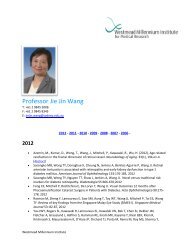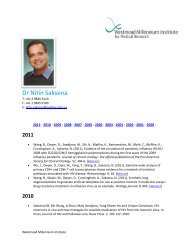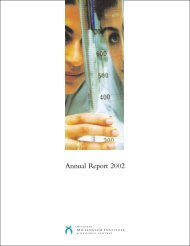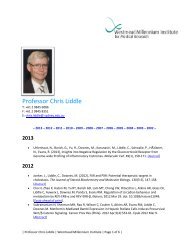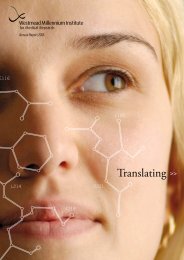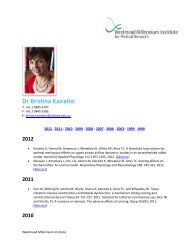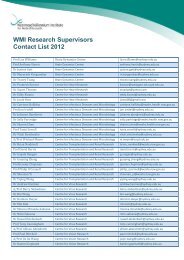Annual Report 2005 - Westmead Millennium Institute
Annual Report 2005 - Westmead Millennium Institute
Annual Report 2005 - Westmead Millennium Institute
Create successful ePaper yourself
Turn your PDF publications into a flip-book with our unique Google optimized e-Paper software.
Cognitive neuroscience and theemotional brainResearchers in this program aim to identify and explore linksbetween brain function, cognition and emotion by focussing onhow the brain determines what is and what is not significant. UsingfMRI, ERP’s and new measures of brain connectivity, researchersaim to identify the location of brain networks for perception ofemotion (fear, anger, disgust, happy and sad). Initial results indicatethere are specialised networks for emotions associated with oursurvival, such as fear.Supported by a prestigious Pfizer Fellowship, A/Prof Lea Williamsand her team are focussing on functional brain connectivity inrelation to emotional brain function, other sources of significanceand the “disconnections” which define psychiatric illnesses. Thisresearch program also aims to evaluate the effectiveness ofpharmaceutical intervention in restoring functional brain connectivityin complex brain disorders. Other research involves investigatingage and gender differences in emotional brain function andcognition. Results from this research may provide insights as togender differences in vulnerability to emotion-related disorders suchas psychosis, PTSD and ADHD as well as the age- related processof cognitive decline.Neuroscientists are increasingly willing to speculate aboutconsciousness, and identifying the neural mechanism of consciousexperience is important in elucidating the factors that distinguishhumans from primates. The study of non-conscious emotionperception is also a central step in understanding the mechanismsof anxiety disorders. Researchers in the Brain Dynamics Centreare integrating a range of neuroimaging techniques tocomprehensively understand the neural mechanisms of consciousand unconscious processing.A significant ARC Linkage Grant enabled the Brain DynamicsCentre to collaborate with researchers from University of Sydneyand University of NSW to integrate brain imaging with genetics. The“Development of integrated biological markers of brain function”collaboration has enabled new projects to be established into theidentification of genetic polymorphisms contributing to variation inbrain function; Prediction of response to antidepressant treatmentin major depressive disorder; and the integration of genotypes withphenotypic data to develop neuropsychological, EEG/ERP and MRIprofiles of known genotypes.Post traumatic and stressPost traumatic Stress Disorder (PTSD) is the most commontraumatic psychiatric disorder to emerge after trauma exposure.Researchers are investigating the identification of temporal andbiological markers for PTSD and the mechanisms of trauma andstress and how these are related to life events.PTSD and depression often present with similar symptoms and alack of precise guidelines for diagnosis lead to increased chance ofmalingering. Research conducted in <strong>2005</strong> involved investigationsinto identifying markers for biological assessment to objectivelyidentify and index PTSD. Further research being conducted incollaboration with both Australian and American groups aims to useEEG to determine if PTSD is a disorder of low approach motivation(similar to depression) or a disorder of high withdrawal motivation(like anxiety). Orienting mechanisms underlie important survivalfunctions from diverting attention to significant or novel stimuli toavoiding harm from aversive stimuli. Research funded by the ARCaims to identify the mechanisms involved with human orienting andinvestigate links with psychological disorders such as PTSD, ADHDand schizophrenia. Finally, investigations are also being conductedinto how childhood trauma may influence physiological stressresponses such as neuroticism or insomnia and whether this canbe used a predictor of depression in later life.Brain modellingThe Brain Modelling Unit collaborates with other groups, locally andinternationally, to develop new methods for biophysical modellingand analysis of electrophysiological and neuroimaging data, as wellas refining and enhancing existing imaging techniques used in otherareas of the Brain Dynamics Centre. The unit developed the firstunified model of the brain based on real physiological information.This model allows us to understand how our data links to real brainactivity and its breakdown in disorder.Brain Resource InternationalDatabase and BRAINnetThe Brain Dynamics Centre is closely affiliated with the BrainResource Company giving scientists the opportunity to undertakeresearch using the Brain Resource International Database (BRID).This database provides a consolidated library of data onpsychological function, cognition, brain function, brain structureand genetics for healthy male and female subjects across a rangeof ages. All data is collected using controlled and standardisedprocedures from labs located in USA, Europe and Australia.BRAINnet is an independent international scientific networkconvened by the Brain Dynamic Centre that oversees access toBRID data. The unique composition of BRID means it can be usedacross scientific disciplines and diseases.



